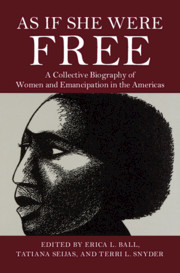Book contents
- As If She Were Free
- As If She Were Free
- Copyright page
- Dedication
- Contents
- Figures
- Contributors
- Elizabeth Catlett and the Form of Emancipation
- Acknowledgments
- Introduction
- Part I Claiming Emancipation during the Rise of New World Slavery
- Part II Experiencing Freedom during Slavery’s Expansion
- Part III Envisaging Emancipation during Second Slavery
- 14 Bessy Chambers, Nineteenth-Century Jamaica
- 15 Minerva, Nineteenth-Century Téjas and Louisiana (US), and Mexico
- 16 Cécile Fatiman and Petra Carabalí, Late Eighteenth-Century Haiti and Mid-Nineteenth-Century Cuba
- 17 Mary Ellen Pleasant, Nineteenth-Century Massachusetts and California (US)
- 18 Gabriela, Nineteenth-Century Rio Grande do Sul (Brazil)
- 19 Maria Firmina dos Reis, Nineteenth-Century Maranhão (Brazil)
- Part IV Enacting Emancipation in the Aftermath of Slavery
- Bibliography
- Index
18 - Gabriela, Nineteenth-Century Rio Grande do Sul (Brazil)
from Part III - Envisaging Emancipation during Second Slavery
Published online by Cambridge University Press: 24 September 2020
- As If She Were Free
- As If She Were Free
- Copyright page
- Dedication
- Contents
- Figures
- Contributors
- Elizabeth Catlett and the Form of Emancipation
- Acknowledgments
- Introduction
- Part I Claiming Emancipation during the Rise of New World Slavery
- Part II Experiencing Freedom during Slavery’s Expansion
- Part III Envisaging Emancipation during Second Slavery
- 14 Bessy Chambers, Nineteenth-Century Jamaica
- 15 Minerva, Nineteenth-Century Téjas and Louisiana (US), and Mexico
- 16 Cécile Fatiman and Petra Carabalí, Late Eighteenth-Century Haiti and Mid-Nineteenth-Century Cuba
- 17 Mary Ellen Pleasant, Nineteenth-Century Massachusetts and California (US)
- 18 Gabriela, Nineteenth-Century Rio Grande do Sul (Brazil)
- 19 Maria Firmina dos Reis, Nineteenth-Century Maranhão (Brazil)
- Part IV Enacting Emancipation in the Aftermath of Slavery
- Bibliography
- Index
Summary
In the 1860’s, Candida manumitted Gabriela and gave her a letter of freedom. Armand nevertheless contested this manumission. He argued that married women were illegally incapable of giving manumission to their slaves without their husband’s consent. Faced with this resistance to her freedom, Gabriela resorted to the courts. She brought two lawsuits against Armand—a civil one and a criminal one, for the crime of reducing a free person to slavery. Gabriela lost both lawsuits. Judges accepted Armand’s argument that a married woman was legally incapable of manumitting a slave without the explicit authorization of her husband, who was the legal administrator of her property. Thus, Brazilian courts nullified Gabriela’s manumission because a married woman had granted her freedom. Gabriela’s judicial struggle was not unique. By analyzing Gabriela’s judicial trajectory, this chapter will address broader questions regarding enslaved women’s access to courts and the role of law in the outcome of judicial claims for freedom in a patriarchal society.
- Type
- Chapter
- Information
- As If She Were FreeA Collective Biography of Women and Emancipation in the Americas, pp. 331 - 343Publisher: Cambridge University PressPrint publication year: 2020



